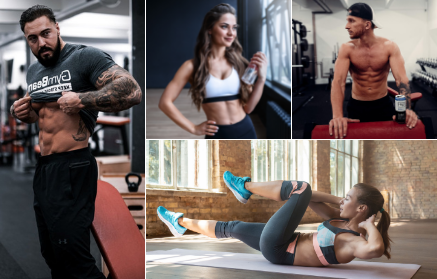Table of Contents
A flat stomach with visible muscles is a dream of many women and men. If someone takes it seriously, they typically can’t do without changing their diet and training routine. Moreover, properly chosen ab exercises play a crucial role in strengthening these muscles. All this brings a more muscular and well-defined stomach, which looks great and even helps with good posture in sports.
You don’t have to worry about an endless series of boring sit-ups, which won’t make a big difference on their own. In today’s article, we will show you several variations that are more effective and interesting to do. You will find here exercises for both beginners and advanced. You can choose, depending on whether you want to strengthen the lower abs, core or focus more on side abs. What’s more all exercises are bodyweight, allowing you to execute them at home in the living room. There is no reason to delay, and you can start working on your six-pack straight away!
What are the benefits of ab exercises?
Ab exercises can help you get an attractive, sexy figure and also a strong core, which is essential for good posture in any activity. The core muscles are involved during strength training, running, yoga and other sports activities.
Strong abs will help you improve in terms of performance in many sports. You can get better stability, coordination, strength, better protection against injury during training, and improve running speed. Last but not least, strong abs are also essential for internal organs and spine protection. [1–3]
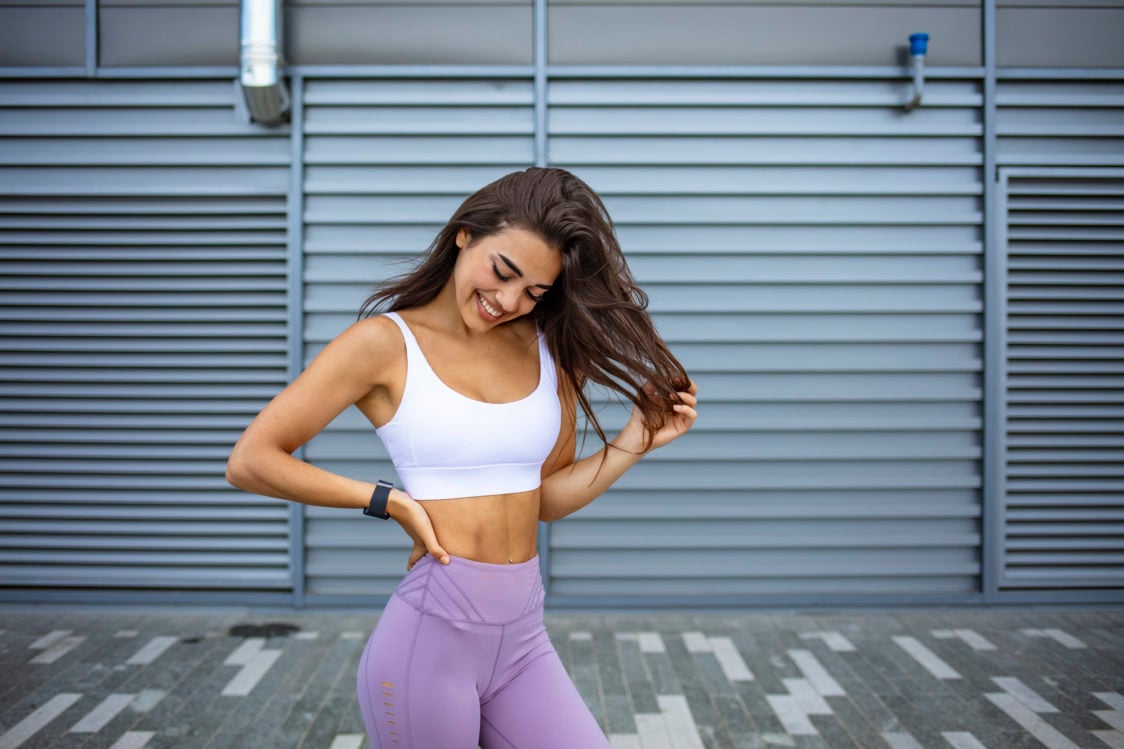
Do ab exercises help you lose weight on your lower abs?
If you are trying to lose belly fat, you should not spend all your time at the gym doing sit-ups, planks, and other exercises. Unfortunately, they cannot burn subcutaneous fat, as it might seem according to the promises made by various articles in lifestyle magazines. We recommend a more comprehensive approach in this regard. You can’t just lose weight in a particular spot on your body where it suits you. [4–5]
When you lose weight, fat reduces from the whole body. And it is affected by genetics, hormones, and the overall lifestyle. You may lose weight first, especially from the thighs, butt, and abdomen a little later. But someone may have it the other way round. [4–5]
The caloric deficit then plays a key role, which you can achieve by adjusting your diet, training, and overall lifestyle. Don’t worry. You don’t have to use drastic diets or detoxes right away. You will lose weight permanently thanks to small changes that will lead you to your goal. The reward will be in the form of lean abs and excellent physical condition. [4–5]
If you want to learn specific tips that can help you lose weight, you can find them in our article Lose Belly Fat and Get in Shape with Our Simple Guide.
You might be interested in these products:
Effective ab exercises according to muscle groups
If you want to get strong abs, you should focus on all its parts. You can’t get muscular legs just by doing quad exercises. Therefore, it is necessary to engage six-pack, oblique, and deep abdominal muscles (the core). Their functions complement each other, and only by comprehensively strengthening all the muscles in your abdomen will you get the best results.
You can perform all these exercises with your own body weight and exercise mat. However, if you want to diversify or make ab workout more difficult, you can use some sports equipment. A set of dumbbells, ankle weights, a balance pad or, a fit ball are perfect for this. Advanced athletes can try an intensive ab workout with a weighted vest or with an ab wheel, which is effective mainly on the core.
1. Six-Pack Exercises
Exercise for rectus abdominis muscle will help you get that dream six-pack that bodybuilders and fitness models often show off on social networks. However, besides the aesthetic function, it also plays a crucial role in movement (bending forward) and the overall stability of the core. For this reason, such exercises are an essential part of a comprehensive ab workout. [6]
1. Crunches
- Starting position: Lie down on your back, bend the knees and leave your feet on the floor. Touch your head with the fingers gently and keep your elbows open. If you tend to pull your elbows together, cross your arms on your chest.
- Performance: Raise your head and upper back off the mat by bracing your abs while exhaling. The lower back remains on the floor throughout the whole exercise. Your eyes should point forward and don’t tilt your head back. It is sufficient to raise it just a couple of centimetres. Then return to the starting position while inhaling and repeat the exercise.
- Common mistakes: Pushing the head with the hands excessively, a small range of motion, insufficient ab activation.
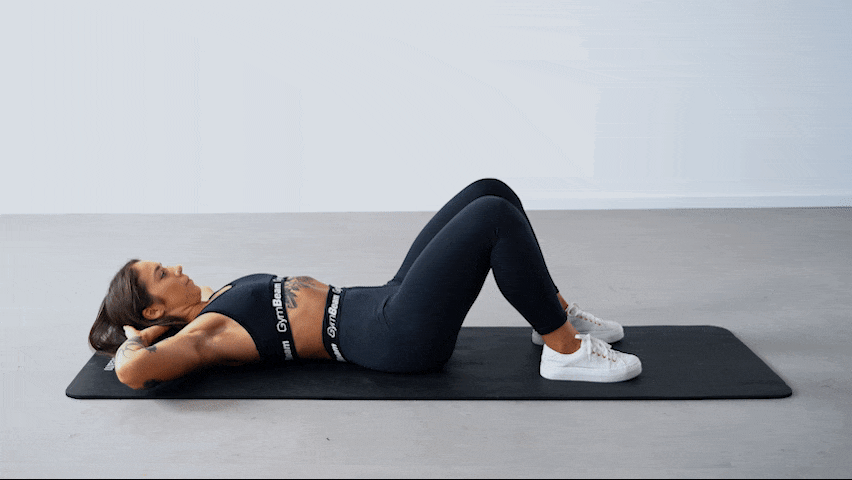
2. Raised Legs Crunch
- Starting position: Lie down on your back, raise your legs towards the ceiling (you can slightly bend your knees). Touch your head with the fingers gently and open your arms to the side. If you tend to pull your elbows together, cross your arms on your chest.
- Performance: Raise your head and upper back off the mat by bracing your abs while exhaling. The lower back remains on the floor throughout the whole exercise. Your eyes should point forward and don’t tilt your head back. It is sufficient to raise it just a couple of centimetres. Then return to the starting position while inhaling and repeat the exercise.
- Common mistakes: Pushing the head with the hands excessively, a small range of motion, insufficient ab activation.
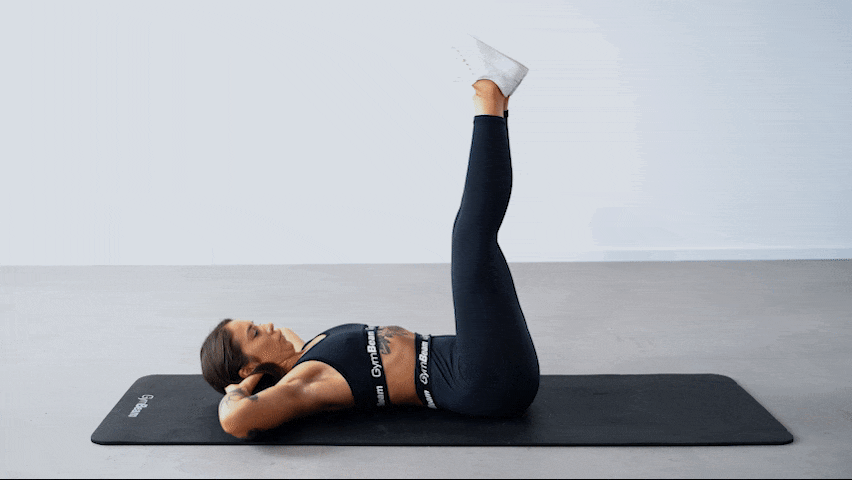
3. Elbow to Knee Crunch
- Starting position: Lie on down your back, place your palms behind your ears and raise straight legs off the ground a couple of centimetres.
- Performance: Raise your head and upper back off the mat by bracing your abs while exhaling. The lower back remains on the floor throughout the whole exercise. At the same time, pull your legs towards you and try to touch your elbows with your knees. Then return to the starting position while inhaling and repeat the exercise.
- Common mistakes: Pushing to the head with the hands excessively, a small range of motion, insufficient ab activation, bent lower back.
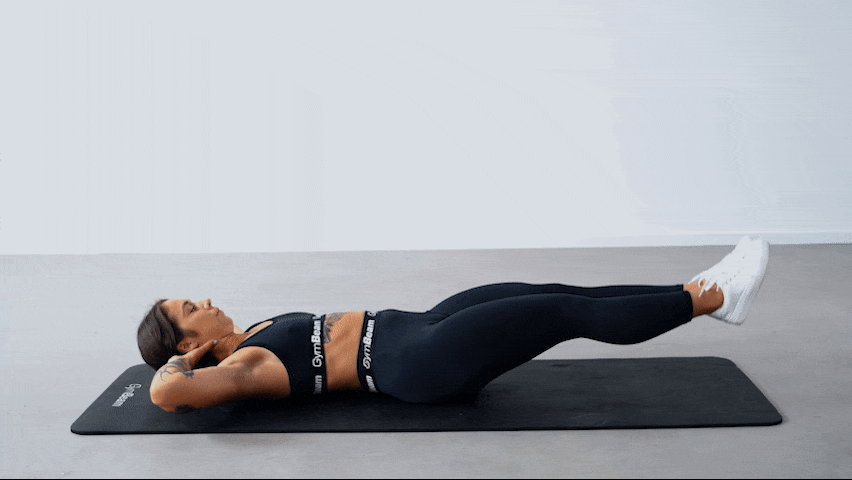
4. Tuck-Ups
- Starting position: Lie down on your back, raise your arms slightly above your body, leave your legs straight and raise them a couple of centimetres off the floor.
- Performance: Raise your head and torso off the mat by bracing your abs while exhaling. At the same time, bend your knees and pull them towards your chest. Then return to the starting position while inhaling and repeat the exercise.
- Common mistakes: A small range of motion, bent back.

5. V-Ups
- Starting position: Lie on down your back and raise your arms. Leave your legs on the floor and raise them a couple of centimetres off the floor.
- Performance: Raise your head and torso off the mat by bracing your abs while exhaling. At the same time, pull your slightly bent legs towards you and try to touch your feet with your hands. Then return to the starting position while inhaling and repeat the exercise.
- Common mistakes: A small range of motion, bent back.
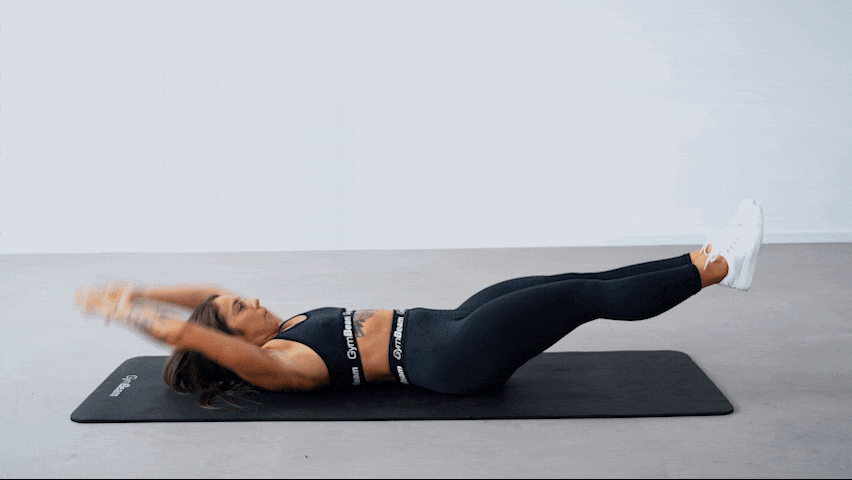
2. Oblique Exercises (Side Abs)
The oblique abdominal muscles consist of several muscle layers and play a crucial role in torso rotations. Together, they function like a natural corset. Thus, it is necessary to pay attention to these muscles, especially if you wish to have a narrower waist. [7–8]
1. Bicycle Crunch
- Starting position: Lie on your back and raise straight legs a couple of centimetres above the floor. Touch your head with the fingers gently and keep your elbows open.
- Performance: Engage your abs and pull your left knee to your right elbow, then subsequently your right knee to your left elbow. Carry on alternating your legs dynamically. Focus on breathing and be careful not to lift your lower back off the mat throughout the whole exercise.
- Common mistakes: Pushing to the head with the hands excessively, a small range of motion, insufficient ab activation, bent lower back.
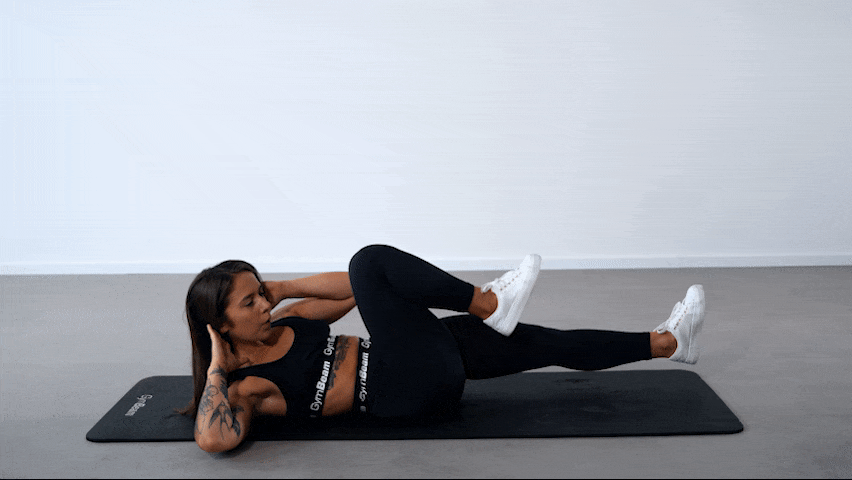
2. Side Plank
- Starting position: Lie on the side with your legs stretched. Place your right foot on the floor, in front of the left leg. Do a plank on your lower stretched arm and raise the upper arm to the ceiling.
- Performance: Breath naturally, keep your body tight and try to remain in this position for a couple of seconds (measure the time on your sports watch or phone). Then switch sides.
- Common mistakes: Bent back, hips fall towards the floor.
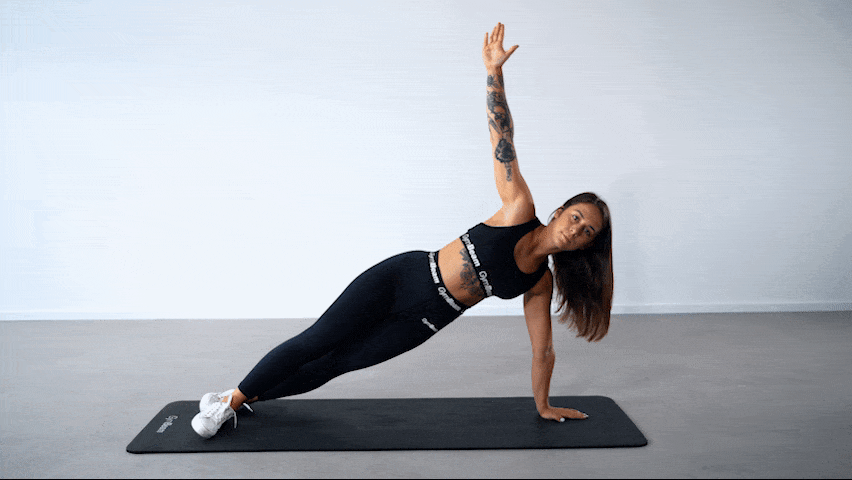
3. Oblique Crunches
- Starting position: Lie down on your back, bend your knees and place them on the side. Touch your head with the fingers gently and keep your elbows open. If you tend to pull your elbows together, cross your arms on your chest.
- Performance: Raise your head and upper back off the mat by bracing your abs while exhaling. Return to the starting position while inhaling and repeat the exercise. Try to keep your legs on the floor. Point your chest upwards. Then do the exercise on the other side.
- Common mistakes: Pushing to the head with the hands excessively, a small range of motion, insufficient ab activation.
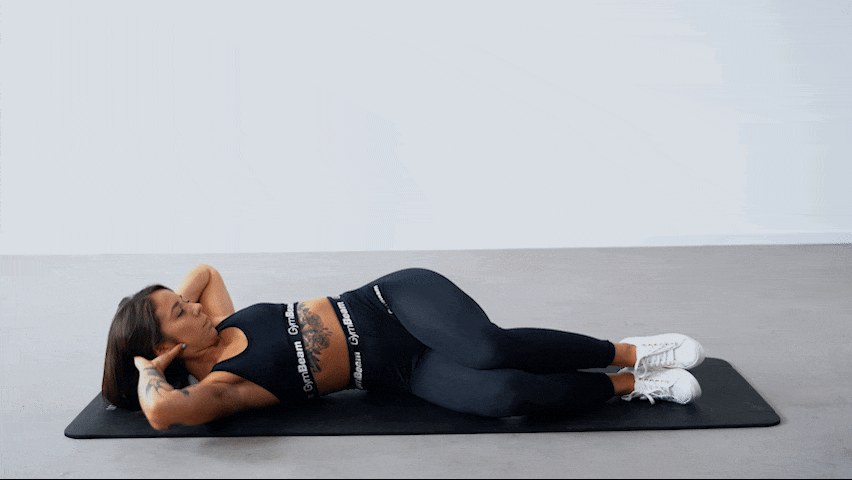
4. Side V-Ups
- Starting position: Lie on the side, raise your lower arm and gently grab your head with the upper arm. You can slightly bend your knees.
- Performance: Raise your head and torso off the floor by bracing the obliques while exhaling. At the same time, raise your legs and try to touch your knee closer to you with your elbow behind your head. Return to the starting position while inhaling, but try not to place your back on the floor completely. Then move on to the next rep. Use the arm on the floor as support only. The movement should be based mainly on the abs. Once you finish one set on one side, move on to the other.
- Common mistakes: A small range of motion, insufficient ab activation, poor coordination of movement.
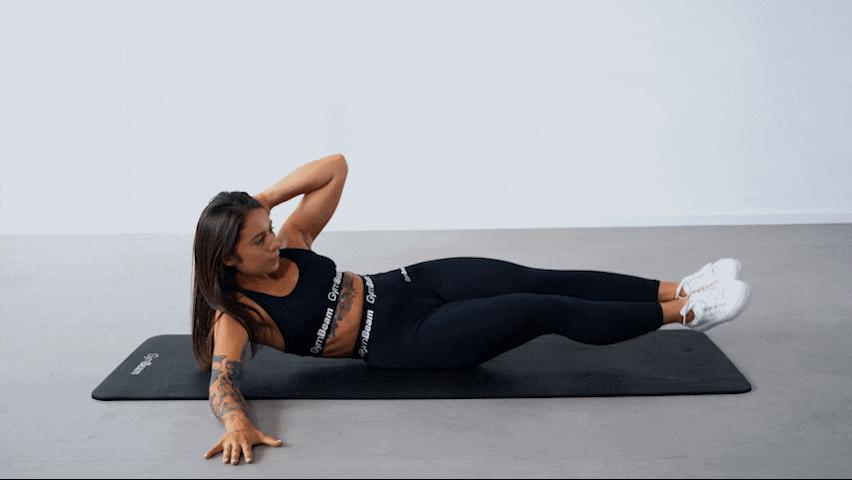
5. Russian Twist
- Starting position: Sit on the mat and bend your knees.
- Performance: Do the rotation with your torso and stretched arms to one side. Focus on engaging the abs and maintaining your back straight. Then move on to the other side. You can slightly touch the mat with your hands. You can increase the intensity of the exercise by lifting your feet off the ground or adding a load in the form of a dumbbell, kettlebell, plate or PET bottle that you have on hand.
- Common mistakes: A small range of motion, bent back.
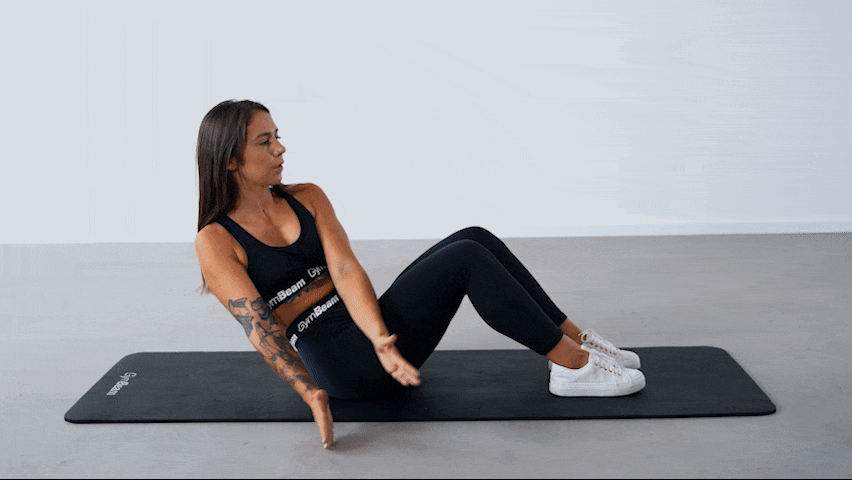
3. Lower Ab Exercises
As we have already said, exercises for the lower abs will not help you miraculously lose fat in this area. Targeted fat loss is a myth. However, such exercises can help strengthen this muscle group. In addition, they are part of the rectus abdominis muscle. So if you strengthen the lower abs, you will also work on your six-pack. If you do not have the strength in this area or consider it problematic, it will help you exercise it regularly. [6–7]
You can also find other effective lower ab exercises in the article What Are the Best Lower Abs Exercises?
1. Reverse Crunch
- Starting position: Lie on your back and place your arms alongside your body. Slightly bend your knees and extend your legs forward.
- Performance: Raise your pelvis and lower back by bracing your abs while exhaling. Return to the starting position while inhaling and repeat the exercise. Focus on engaging the abs.
- Common mistakes: A small range of motion, insufficient ab activation, uncontrolled movement.
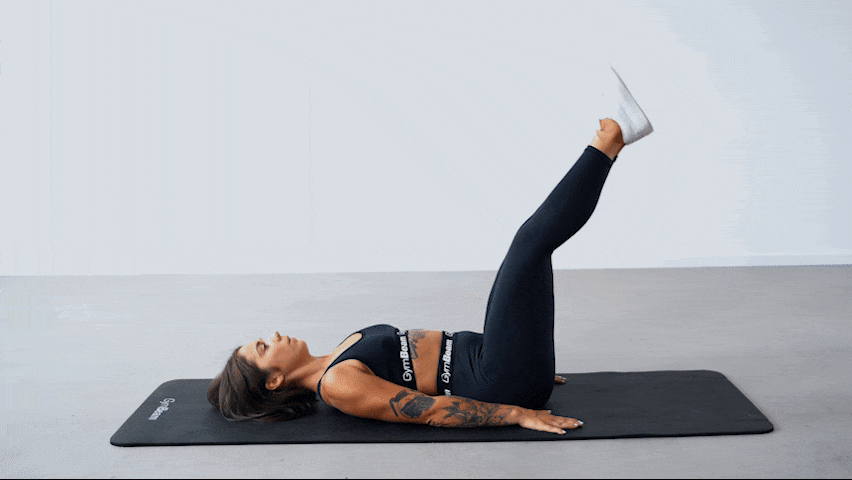
2. Flutter Kicks
- Starting position: Lie on your back. Raise your head, upper back, and straight legs a couple of centimetres off the floor. Place your arms alongside your body and use them as support.
- Performance: Engage your abs and try to flutter your legs from side to side. Alternate your legs dynamically by fluttering one leg over the other. Don’t forget to breathe during the exercise and focus on engaging the abs. Also, make sure that your lower back is always on the mat. You can increase the intensity of the exercise by lowering your legs.
- Common mistakes: A small range of motion, insufficient ab activation, bent lower back.
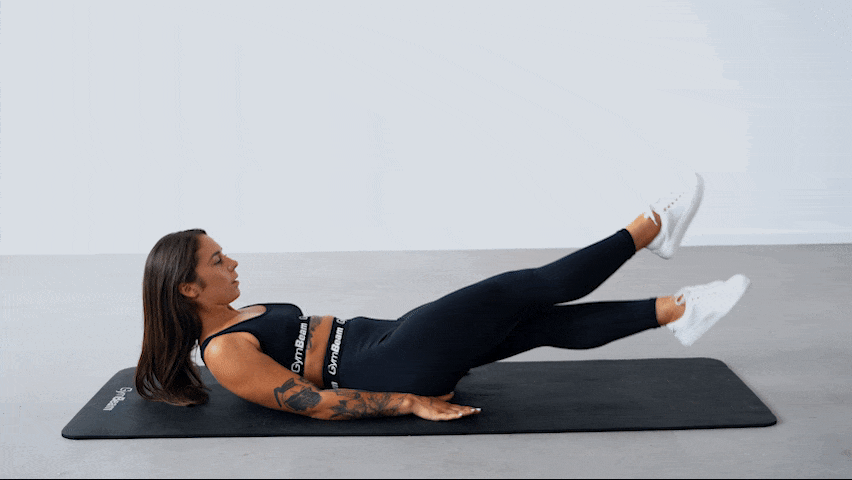
4. Bicycle
- Starting position: Lie down on your back. Raise your head, upper back, and slightly bent legs a couple of centimetres off the floor. Touch your head with the fingers gently and keep your elbows open. If you tend to pull your elbows together, cross your arms on your chest.
- Performance: Activate your abs and start doing circular motions with your legs as if cycling. Don’t forget to breathe during the exercise and focus on engaging the abs. Also, make sure that your lower back is always on the mat. You can increase the intensity of the exercise by lowering your legs or by doing bigger circles.
- Common mistakes: A small range of motion, insufficient ab activation, bent lower back.

4. Scissors
- Starting position: Lie down on your back. Raise your head, upper back and slightly bent legs a couple of centimetres off the floor. Keep your elbows open. If you tend to pull your elbows together, cross your arms on your chest.
- Performance: Engage your abs and start pulling one leg towards your chest and simultaneously placing the other a couple of centimetres above the floor. Your legs should resemble scissors. Don’t forget to breathe during the exercise and focus on engaging the abs. Also, make sure that your lower back is always on the mat. You can increase the intensity of the exercise by lowering your legs or by enlarging the range of motion in your legs.
- Common mistakes: A small range of motion, insufficient ab activation, bent lower back.
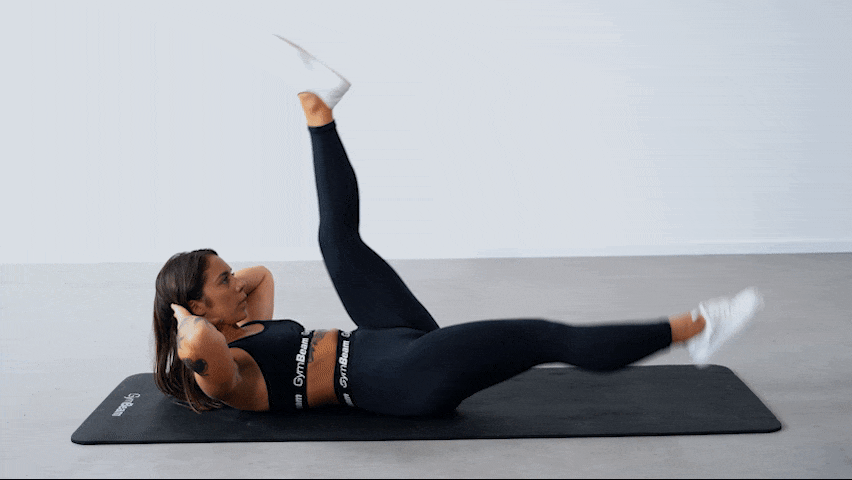
5. Toe Taps
- Starting position: Lie down on your back. Raise your head, upper back a couple of centimetres off the floor. Touch your head with the fingers gently and keep your elbows open. If you tend to pull your elbows together, cross your arms on your chest. Raise your legs and bend your knees (90 degrees).
- Performance: Touch the mat with the tip of one leg while exhaling and return it while inhaling. Do the same with the other leg. Focus on engaging the abs. Also, make sure that your lower back is always on the mat. You can increase the intensity of the exercise by slightly straightening your legs.
- Common mistakes: A small range of motion, insufficient ab activation, bent lower back.
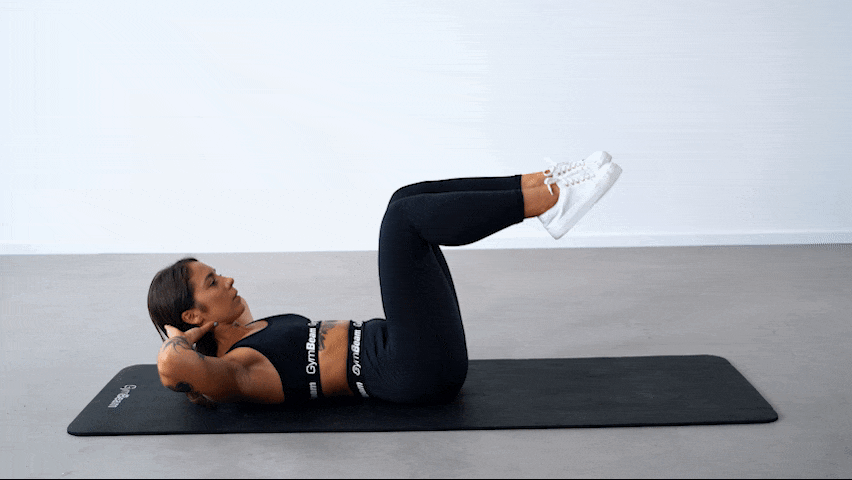
4. Core Exercises
A strong core is the alpha and omega of good posture. It connects the upper and lower body, and its proper function is substantial for all physical activities. Therefore, core exercises should be part of any ab workout plan. [1]
You can find other effective core exercises in our article 17 Most Effective Abs Exercises.
1. Plank
- Starting position: Lay on the floor with your elbows under your shoulders, and get to the low plank (with the forearms on the floor). Pull the shoulders back and down and the shoulder blades together. Bend your elbows about 45 degrees. Activate your core and try to maintain your body in a straight line. Don’t bend your back, especially in the lumbar spine.
- Performance: Breath naturally, engage each muscle and try to remain in this position for a couple of seconds (measure the time on your sports watch or phone).
- Common mistakes: Bent back, the hips fall towards the floor, excessive pelvis raise.
If you are interested in how exercising plank regularly can affect your body, read our article What Will Happen if You Do Plank Every Day?
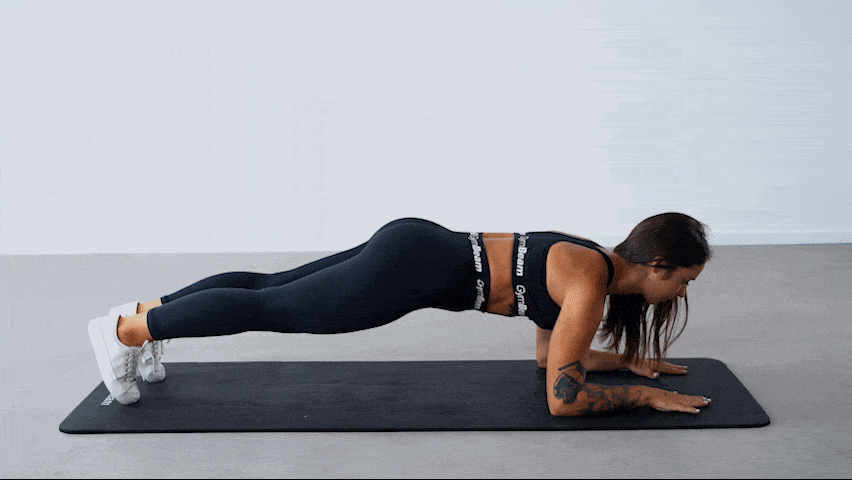
2. Plank Jack
- Starting position: Start in plank position with your arms straight and hands under your shoulders, feet together. Bend your elbows about 45 degrees. Activate your core and try to maintain your body in a straight line. Don’t bend your back, especially in the lumbar spine.
- Performance: Engage your core and Jump both feet out wide to each side as if you were doing a horizontal jumping jack. Breath naturally and try to repeat this movement for a couple of seconds or reps. The wider you keep your legs, the harder the exercise will be.
- Common mistakes: Bent back, the hips fall towards the floor, excessive pelvis raise.
You can also find other fun and effective plank variations in our article 47 Best and Fun Plank Variations.

3. Bird Dog Plank
- Starting position: Start in a plank position. Pull the shoulders back and down and the shoulder blades together. Bend your elbows about 45 degrees. Activate your core and try to maintain your body in a straight line. Don’t bend your back, especially in the lumbar spine.
- Activate your core and try to maintain your body in a straight line. Don’t bend your back, especially in the lumbar spine.
- Performance: Raise and stretch the opposite arm and leg (just a couple of centimetres above the floor) while exhaling. Then return to the starting position while inhaling and do the exercise on the other side. If this exercise is too demanding for you, you can stay in the plank without lifting your limbs.
- Common mistakes: Bent back, the hips fall towards the floor, uncontrolled movement, a small range of motion.
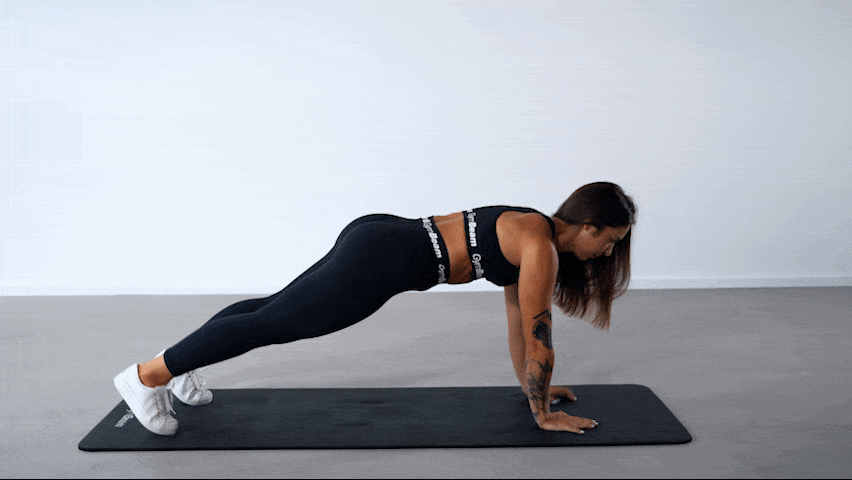
4. Superman
- Starting position: Lie on your stomach with your legs straight. Raise your arms upwards.
- Performance: Engage your core and raise your arms, head, chest, and legs a couple of centimetres above the floor. Remain in the upper position for a couple of seconds, then return to the starting position while inhaling and repeat the exercise.
- Common mistakes: Bent back, uncontrolled movement.
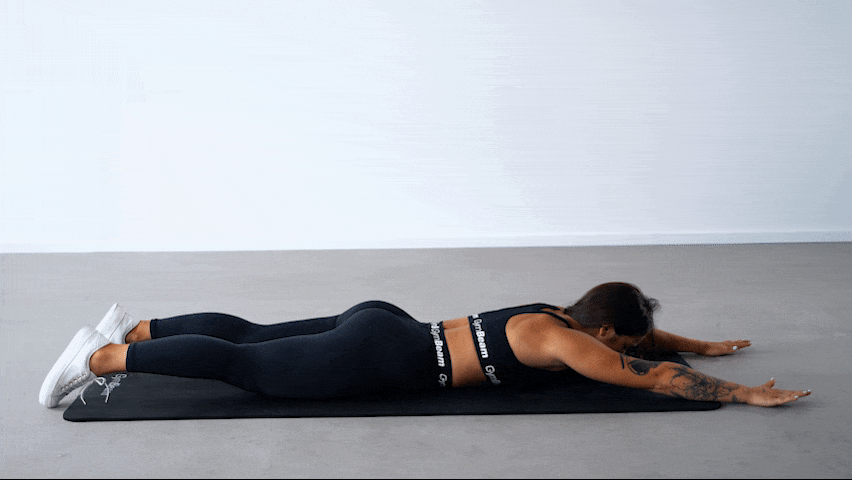
5. T-Stabilisation
- Starting position: Start in high plank position (on the straight arms). Place your palms under your shoulders (which are back and down), and pull your shoulder blades together. Engage your core and try to keep your body in a straight line. Don’t bend your back.
- Performance: Turn to the right side, shift your weight to your left arm, and raise your right arm towards the ceiling while exhaling. Return to the starting position while inhaling and repeat the exercise on the other side. The movement should be dynamic yet controlled.
- Common mistakes: Bent back, the hips fall towards the floor, uncontrolled movement, a small range of motion.
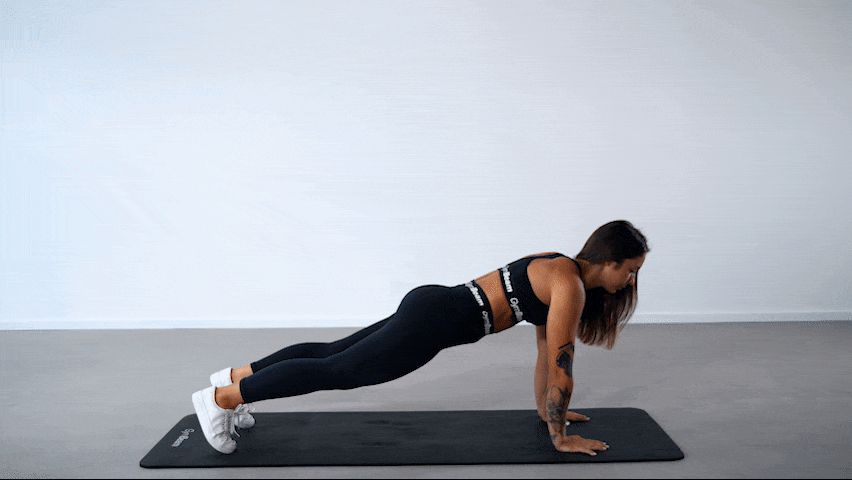
6. Bird Dog
- Starting position:Kneel down on the floor on your hands and knees in the all-fours position
- Performance: Engage your core and raise and stretch the opposite arm and leg. Then return to the starting position while inhaling and do the exercise on the other side.
- Common mistakes: Bent back, uncontrolled movement, a small range of motion.

Sample Abs Workout for Beginners
If you are beginning with your fitness journey, choose easier exercises and focus on the correct technique. Be persistent, build a quality foundation and gradually work your way up to more advanced and challenging exercises. For a start, try our sample training and include it in your training plan 2–3 times a week.
Exercise | Number of reps | Number of sets |
|---|---|---|
| Crunches | 8–12 | 2–3 |
| Toe Taps | 8–12 | 2–3 |
| Side Cruches | 8–12 on both sides | 2–3 |
| Russian Twist | 8–12 | 2–3 |
| Plank | 15–30 seconds hold | 2–3 |
Sample Ab Workout for Advanced
If you have been working out for some time, try our workout for advanced athletes. You can then include it 2–4 times a week.
Exercise | Number of reps | Number of sets |
|---|---|---|
| V-Ups | 10–15 | 2–4 |
| Scissors | 12–20 | 2–4 |
| Reversed Crunches | 10–15 | 2–4 |
| Plank Jack | 10–15 | 2–4 |
| Flutter Kicks | 12–20 | 2–4 |
| Side Plank | 40–60 second hold on both sides | 2–4 |
Intensive Bodyweight Core Workout
You can also work on your abs using our video workout, which includes core exercises. You don’t need any equipment for it, and you will be finished in 5 minutes.
What should you remember?
These exercises can help you on your way to a flat stomach, a dream six-pack or a narrower waist. In addition, they bring many other benefits, such as better posture or sports performance. From the above exercises, you can easily choose whether you want to focus on strengthening the lower abdomen, hip area, or core.
You can also try our sample abs workout for beginners or advanced athletes. In addition, these are all bodyweight exercises, so you can start working on your abs right away. To increase the intensity of the exercises use dumbbells or balance pads.
Did you find this article helpful? If so, share it with your friends to inspire them for an ab workout.
[1] Better Health Channel. Abdominal muscles. – https://www.betterhealth.vic.gov.au/health/conditionsandtreatments/abdominal-muscles
[2] Sharrock, C., Cropper, J., Mostad, J., Johnson, M., & Malone, T. A PILOT STUDY OF CORE STABILITY AND ATHLETIC PERFORMANCE: IS THERE A RELATIONSHIP? – https://www.ncbi.nlm.nih.gov/pmc/articles/PMC3109894/
[3] BridgeAthletic. Designing a Strength Program: Importance of Core Stability. – https://blog.bridgeathletic.com/designing-strength-program-importance-of-core-stability
[4] PubMed. Fat loss depends on energy deficit only, independently of the method for weight loss.– https://pubmed.ncbi.nlm.nih.gov/18025815/
[5] Precision Nutrition. How To Lose Belly Fat, According to Science. – https://www.precisionnutrition.com/how-to-lose-belly-fat
[6] Physiopedia. Rectus Abdominis. – https://www.physio-pedia.com/Rectus_Abdominis
[7] Physiopedia. Abdominal Muscles.– https://www.physio-pedia.com/Abdominal_Muscles
[8] Core Healthcare. The Core and Corset – one and the same? – https://corehealthcare.com.au/core_and_coreset/

